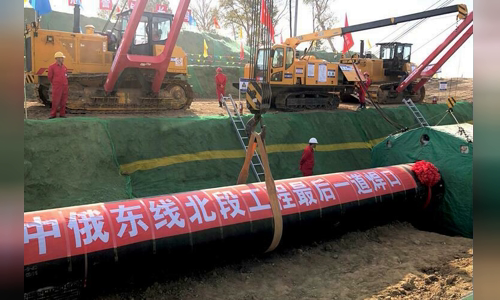Putin and Xi set up the "Siberian Energy" pipeline to bring gas from Russia's Far East to China today.
The ground-breaking ceremony of the project, conducted by Russian President Vladimir Putin and Chinese President Xi Jinping, was one of three ambitious projects to strengthen Moscow's leading gas export.

Workers work at a gas pipeline construction site in a cooperation project between Russia and China in Heilong, China on October 16. Photo: Reuters
The "Siberian Energy" pipeline, viewed by Russian President Vladimir Putin as the world's largest construction project, is the result of years of negotiations between Russia and China.
The two-year contract worth US $ 400 billion was signed by both sides in 2014, under which Russia will provide China with 38 billion cubic meters of gas annually when the pipeline is fully operational from 2025. This is also the case. Gazprom's largest copper, Russia's energy giant.
Dmitry Peskov, a Kremlin spokesman, said that the 3,000-kilometer Siberian Energy gas pipeline from remote eastern Siberia to the Chinese border is of great importance to both Russia and China, emphasizing that The project will create jobs and promote infrastructure in the Far East.
Gazprom said the pipeline ran through "marshes, mountains, seismic activity areas, permafrost and rocks with extreme environmental conditions". Temperatures along the pipeline have dropped to -60 degrees Celsius like in Yakutia and -40 degrees Celsius in Amur, Russia's Far East.
Chinese Deputy Foreign Minister Lac Ngoc Thanh said in Moscow last week that the "Siberian Energy" pipeline would help the two countries strengthen cooperation and "complement each other's strengths".
Russia is also planning to soon start construction of two TurkStream and Nord Stream-2 gas pipelines to provide gas to Europe without going through Ukraine. TurkStream, a gas pipeline project from Russia to Turkey, is expected to be operational by January 2020, while Nord Stream-2, the pipeline that will help double the amount of gas to Germany, is expected to begin. operate from mid-2020.
Experts say the three projects have long-term political and economic interests for Russia, helping the country penetrate the European market in the west and the Chinese market is on the way of rapid growth in the east. "Russia not only benefits from the gas flow but also expands markets and strengthens its strategic position," said Andrew Hill, a leading energy expert at S&P Global Platts.
Before the "Siberian Energy" pipeline was started, Russia and China completed the construction of the first road bridges linking the territory of the two countries. The bridge is expected to come into operation in 2020, connecting the Russian city of Blagoveshchensk and Heilong City, northern China.



 EdelwinaCereza
EdelwinaCereza







